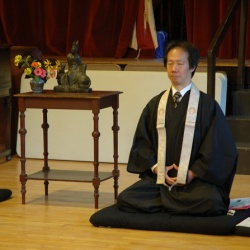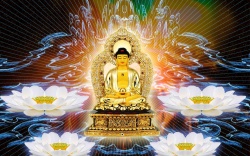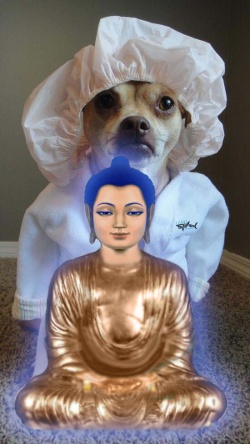Aspects of a Buddhist Deity
Any Buddhist deity may manifest in four ways: benign, active, semi-wrathful and wrathful. That is, their activity is pacifying, enriching, magnetizing, or subduing/destroying. The four-armed form of the protector, Mahakala, seen above, demonstrates by means of his gestures or mudras, all 4.
An example of a wrathful deity is Guru Drakpur. This is a manifestation of Amitabha's activity via Padmasambhava as Vajrakilaya, vanquisher of malevolent obstructions [lit.>Sanskrit: indomitable sin-eliminator].
Originations:
There may be some variety in the description of a deity in the Vajrayana or tantric Buddhist tradition. One reason for this is that sadhanas, or ritual practices of a deity may have appeared, been revealed, uncovered or discovered, via different teachers in different places and times.
It was often the case that a practice had a long tradition in South India where the fame of its efficacy and of its masters drew Tibetan teachers/translators to undertake the arduous journey to fetch it for the benefit of beings of northern Buddhist lands.
However, sometimes circumstances did not permit its wide dissemination, and it was then concealed or secreted for use at a later time. Re-discoverers are known as tertons, and revealed tantras are called termas.
Especially effective or popular sadhanas can exist in a multiplicity of forms as a result of the denomination and/or the distinctive teaching lineage of practitioners.
Vajrakilaya (also, Benzarkila or Vajrakila. Tibetan: Dorje Purba) is a winged dark blue wrathful deity or heruka whose characteristic implement is the purba phurba, the 3-sided 'spirit nail.' He is said to have appeared as an aspect of Padmasambhava to subdue the opposing and chaotic forces which tried to prevent all activities motivated by compassion and generosity from penetrating Tibetan culture. [Link is to Tibet Art image of Nyingma/Sakya lineage tangka.]
When Vajrakilaya works through the activity of the purifier, Vajrasattva, he is called Vajrakumara (Tib. Dorje Shönnu), or Indomitable Prince.
Vajrakilaya is also considered the wrathful embodiment of bodhisattva, Vajrapani, as he acts to subdue, purify and transform the actions of those whether gods, rakshas or people, who seek accomplishment or power for selfish or irresponsible reasons.


